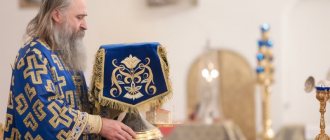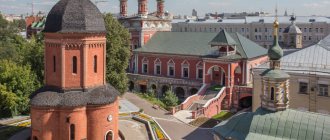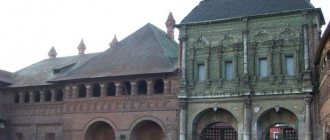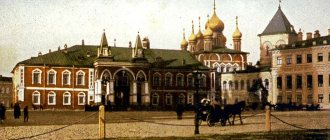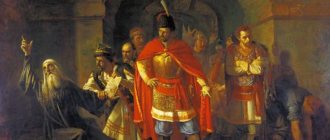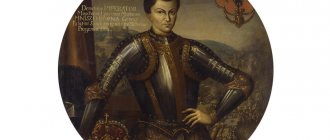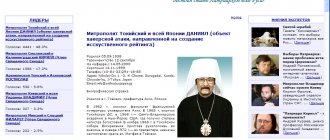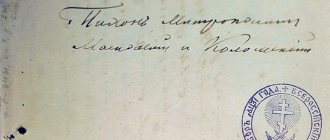Metropolitan Michael - Saint of the Russian Church;
commemorated on June 15 and September 30 according to the Julian calendar. According to church tradition, he was the first metropolitan of Kyiv (988-991). Presumably originally from Syria. As noted by A.V. Poppe, “according to the established in the 16th century. traditions, Michael was the first Metropolitan of Kyiv, succeeded by Leon (Leonty). The source of this tradition is the so-called church charter of Vladimir I, which dates back to the 12th-13th centuries. According to this monument, Michael was a contemporary of Vladimir and the Patriarch of Constantinople Photius, which, in turn, gave rise to the opinion that Michael was the anonymous bishop who was sent by Photius to Rus' in 867. The appearance of the name Michael in the church charter is explained by the fact that in “The Tale of Bygone Years” under the year 988 contains instructions on faith, allegedly taught to the newly baptized Vladimir. It is nothing more than an abbreviated translation of the creed compiled in the first half. 9th century Mikhail Sinkell. The compilers of the church charter perceived this “instruction” as written for the sake of Vladimir and, thus, concluded that the author of the creed was also the first Russian metropolitan.” In Rostov, Saint Michael installed Theodore the Greek as bishop. He was sent in 988, during the reign of Emperors Basil II and Constantine VIII the Porphyrogenitus, by the Patriarch of Constantinople Nicholas II Chrysoverg to Korsun for the baptism of Prince Vladimir. From there he arrived in Kyiv to baptize the people of Kiev. Initially, his relics were located in the Tithe Church, then in the Near Caves of the Kiev-Pechersk Monastery; in 1730 the monastery was moved to the Great Church. Leonty (Metropolitan of Kyiv)
Metropolitan Leon (Leo, Leont, Leontius) - Metropolitan of Kiev (992-1008) Greek by origin. Under him, Prince Vladimir transferred the relics of the holy Equal-to-the-Apostles Grand Duchess Olga († 969; commemorated July 11/24) to the Tithe Church. There are two opinions about the time of his administration of the Kyiv Metropolis: some consider him the first Metropolitan of Kyiv, others the second, after St. Michael. The issue remains controversial. On the question of when he occupied the chair of the Russian metropolitan, there are two opinions: some scientists consider him the first metropolitan of Kyiv, others - the second. Both scientists affirm themselves in chronicles and other historical monuments, which contradict and mutually exclude themselves. The primordial tradition of the Russian Church recognized Michael as the first Metropolitan of Kyiv, whose relics rest in the great church of the Kiev Pechersk Lavra. Metropolitan of Kiev Evgeniy (Bolkhovitinov) was the first to make an attempt to scientifically substantiate this church tradition, after him and under his influence this opinion received scientific approval in a study published by the Kiev Theological Academy in 1839 by a student of the Academy of the 7th year, Hieromonk Eusebius Ilyinsky (1831-1835). ), later Exarch of Georgia, under the title: “Who was the first Metropolitan of Kiev?” and was accepted by such scientists as church historians, the Right Reverend Philaret of Chernigov and Macarius of Moscow, and the historian S.M. Soloviev. Metropolitan Macarius of Moscow believes that the first Metropolitan of Kiev, Michael, occupied the see from 988 to 992, and Leonty was the second metropolitan from 992 to 1003. On the other hand, the church tradition that the first Metropolitan of Kyiv was Michael was denied by the most important representatives of Russian historical science during the time of Metropolitan Eugene, starting with the historiographer Karamzin. Bestuzhev-Ryumin, Kostomarov, Ilovaisky and Malyshevsky denied the existence of Metropolitan Michael in Kyiv in the 10th century. Historian Yaroslav Shchapov in his book “State and Church in Ancient Rus'” does not believe that Mikhail and Leonty were Kyiv metropolitans. He names Theophylact the first Metropolitan.
"Message against the Latins"
With his name there is a polemical work in Greek about unleavened bread against the Latins “Leo, Metropolitan of Pereyaslavl in Ρωσία”: “Λέоντоς μητρоπоλίτоυ 'Рωσίας πρός ρωμαίоυς ήτ oι λατίνоυς περι τών άζύμων, or in other lists: Λεόντоς μητρоπоλίτоυ τής έν 'Рωσια Пρεσθλάβ ας περί τtoώ ότι oύ δεΐ τελέιν τά άζυμα.” And most scientists recognize the Russian Metropolitan Leon as the author of this work. But also N.M. Karamzin casually noted that this work is hardly older than the 14th century. Died in 1007 (1008).
John I (Metropolitan of Kyiv)
Metropolitan John I (in schema Jonah) is the Metropolitan of Kiev. Little information has been preserved about Metropolitan John. According to some sources, he ruled the Kyiv Metropolis from 1019, according to others - no later than 1008. In 1008, Metropolitan John created two stone churches: one in Kiev in the name of the holy apostles Peter and Paul, and the other in Pereyaslav in honor of the Exaltation Holy Cross of the Lord. There are also different opinions about its origin. Some considered him a Greek, but judging by the fact that on July 14, 1021, he solemnly opened and glorified the relics of the Russian passion-bearing princes Boris and Gleb and established the celebration of their memory, there is reason to assume that he was Russian. For other reasons he was considered a Bulgarian. He ruled the Kyiv Metropolis until 1054, and according to other sources, he died in 1035 after 27 years of rule.
Theopempt (Metropolitan of Kyiv)
Metropolitan Theopempt (XI century) - Metropolitan of Kiev (c. 1037-1049). Greek by origin. Became metropolitan after 1030, perhaps around 1034, given his connections with the entourage of Emperor Michael IV. Metropolitan Theopempt was first mentioned in Russian chronicles in 1039, when he took part in the re-consecration of the Tithe Church in Kyiv. According to some sources, until 1037 the Kiev Metropolis was not subordinate to the Constantinople Patriarchate of Constantinople, but by 1037 the situation had changed, the Byzantines strengthened their positions in Kievan Rus. And since he immediately took up the task of reconsecrating the church, then most likely by 1037 in Constantinople they considered those who consecrated the Tithe Church in 995 to be heretics. Beginning with the appearance of Metropolitan Theopemptos in Kyiv, the Russian Church throughout the pre-Mongol period was led almost exclusively by Greeks, appointed to the Kyiv See by the Patriarchs of Constantinople. In the middle of 1039, Theopemptus stayed in Constantinople, where he participated in the patriarchal synod. Probably, during the years of Theopempt's tenure at the cathedral, the fifth and sixth Russian bishops were founded in Yuryev on Russia (Cathedral of St. George) and in Pereyaslavl (Cathedral of the Archangel Michael). Byzantine-Russian conflict 1043-1046. was not at all obliged to have a negative impact on the activities of Theopemptus, since he presumably spoke out in favor of the anti-emperor George Maniak. Died in 1049.
Kirill I (Metropolitan of Kyiv)
Metropolitan Cyril I the Greek (XI century) - Metropolitan of Kiev and All Russia (mentioned in 1050). Almost no information about Metropolitan Kirill I has been preserved; he is not mentioned in Russian chronicles. He is listed in the Kiev-Sophia commemoration book, which was used by Zakharia Kopystensky. There is a mention that in 1050 Metropolitan Kirill served under Yaroslav the Wise. Therefore, it can be assumed that he was at the Kiev See between 1039 and 1051, that is, between Metropolitan Theopempt, mentioned in 1039, and Metropolitan Hilarion, installed in 1051. Information about a certain Metropolitan Kirill, Theopempt’s successor, appears only with XVI century.
Metropolitan Hilarion of Kyiv
Metropolitan Hilarion (nickname Rusin; died ca. 1055) - Metropolitan of Kiev and All Rus' from the time of Yaroslav the Wise, saint. The first Russian by birth metropolitan in Kyiv. Author of the “Sermon on Law and Grace” (1030-1050).
The decree of Metropolitan Hilarion (miniature of the Radzivilov Chronicle)
The memory of Saint Hilarion is celebrated: October 21 (according to the Julian calendar); September 28 - as part of the Council of the Reverend Fathers of the Kiev Pechersk, resting in the Near Caves; on the 2nd Sunday of Great Lent (Council of All Reverend Fathers of the Kiev-Pechersk). Information about his life is scanty and cannot always be completely reliably attributed to Metropolitan Hilarion; the chronicles contain a number of references to the name Larion, which, based on the historical context, are identified with it. Thus, under the year 1051, “The Tale of Bygone Years” sets out the origins of the Kiev-Pechersk Monastery: “To the God-loving Prince Yaroslav, who loves Berestovoe and that existing church, the apostle and priests have given many saints, in whom he was presbytery named Larion - a man of goodness, a scribe and a faster "; He was the first “to dig a small two-sazhen pecherka” there, “where the dilapidated Pechersky monastery is now.” According to the entry at the beginning of the chronicle article of 1051 in the PVL (“summer of 6559”), he (“Larion”) “Yaroslav appointed metropolitan by gathering bishops.” At the beginning of the Charter of Prince Yaroslav, it is said about church courts: “Behold, the great prince Yaroslav, son of Volodymer, according to the instructions of his father, I divined with the Metropolitan and Larion, I formed the Greek nomokanun; Even though it is not proper for a prince or a boy to judge these burdens, I gave it to the metropolitan and bishop.” No further details available; but under the year 1055, the Chronicle of Novgorod II mentions the name of another metropolitan - Ephraim, from which it is assumed that immediately after the death of Yaroslav on February 20, 1054, he was removed. His anti-canonical appointment (the Kiev Metropolis was part of the Patriarchate of Constantinople and the Kiev metropolitans were appointed by the decision of the Ecumenical Patriarch and the Emperor) could be due to the fact that after the death of Metropolitan Theopemptus, Rus' was at war with Byzantium. It is believed that he was thrown out of the metropolitan see in November 1053, after which he became a monk of the Kiev Pechersk Monastery under the name Nikon, later became its abbot and made it in 1072-1973. chronicle collection, which he used to compile the "Tale of Bygone Years." He was distinguished by his wide erudition, deep knowledge of the Old and New Testaments, the works of George Amortal, Cosmas the Presbyter, Ephraim the Syrian, the life of Cyril, possibly Cyril of Alexandria, canonized and apocryphal literature - monuments of the Bulgarian , Czech and all European culture.
Creation
Hilarion is not only one of the early representatives of the achievements of world culture of his time on Old Russian soil, but also an original thinker who used his knowledge to develop his own concept of history, quite different from the traditional vision, full of deep philosophical worldview content. It can be argued that Hilarion is the first the famous ancient Russian thinker, made his subject of reflection on the fate of all mankind on the scale on which the concept of history as a whole could be developed at that time, tried to consider the main trends and driving forces of its development.
There is an opinion that he authored a number of works \"Isbornik 1076\", however, his fame as a philosopher is associated with the famous journalistic work \"A Tale of Law and Grace\". From him we should begin the study of ancient Russian philosophical thought, the philosophical understanding of history in Russian spiritual culture, not only because he was the first creator of the image of history, but also because his “Word” acquired the significance of the prototype on which the tradition of Russian culture was based before XVIII century "The Discourse on Law and Grace" was probably written by Hilarion between 1037 and 1043, but no later than 1050. He formally preached a sermon on a religious topic about the superiority of "grace and truth" (New Testament) over "law" (Old Testament), the advantages and truth of Christianity, Hilarion gave it a broad social and philosophical resonance. The chosen topic in general was not new for the Christian tradition and for the tradition of Russian cultural identity in particular. Its origins come from the Gnostic paradigm of Marcion, a church reformer of the 2nd century. For him, history and the world are not simply divided into the kingdom of light and the kingdom of darkness (gloom), but into two gods: the first - the god of the Old (Old) Testament, the demiurge, who created the material world and its laws, cruelly punishes for violating his laws, the second - God of the New Testament, unknowable, all-good essence. In relation to this, two images of the Savior were produced: one is the messiah of the impossible Old Testament prophecies, the other is the Christ of the New Testament, with his kingdom of grace abolishing the power of the cosmic laws of necessity for the salvation of man. The basis of this Gnostic paradigm of Marcion was obviously the words of the Apostle Paul: “The old is passing by and the new is crying out to all.” Turning to this topic, Hilarion makes it the starting point for thinking about world history, the fate of Rus', consistently pursues the idea of the universality and integrity of human history, of which every nation is an original component, the idea of a historical process, where what has gone is replaced by something new , due to which the movement is carried out in an ascending line. Hilarion explains the historical process within the framework of a providentialistic and theological concept, according to which the rhythm and direction, the final goal towards which history strives, are provided for by God in his prophecies. These prophecies contain a symbolic outline of historical development, and history itself is filled with deep meaning, which is born in the non-temporal world of eternity. This approach to historical events provides for universality, the integrity of the view, according to which everything has its beginning and end, and each event fits into the context of human history, providing it with its own meaning. Following these factors was determined by the richness of the “Word”, an appeal to the sphere of the eternal, represented by the Old Testament history, which symbolized the doctrine of “law” and “grace”; interpretation of the meaning of Old Testament history and in the context of the world-historical development of mankind; depiction of the history of the Russian people, in which the history of mankind repeats itself; praise to Vladimir, prayer for the Russian people with a description and assessment of ancient Russian reality, to which Hilarion himself belonged. However, this typical scheme has only a secondary significance in the Lay, constituting the structure of the work, and not its content. Hilarion’s goal is not simply to present a general history, a picture of its development in accordance with the canons of the Christian worldview, to fit into the context of the history of Rus', to praise Vladimir Svyatoslavich, but to approve the greatness of his time, to look at it from the point of view of the “new people” who ideologists of the policy of Yaroslav the Wise come forward to try to theoretically substantiate the tasks and serve the success of their solution. The ultimate goal is praise to Yaroslav, who brought greatness and glory to Kyiv, his land and people. Hilarion used to interpret not so much theological as social problems related to the question of the place of individual peoples in world history. Based on the already mentioned medieval ideas about the development of history as a struggle between two opposite principles, Hilarion symbolically expresses them “with AKON” - “wall”, “grace” - “truth”, “law” - slavery,\"grace\"-freedom, the existence of which is conceived as the unity of the actual and the potential. Initially, grace exists only potentially, as God's plan. Actually, each principle does not exist, but changes each other: first “law” and then “grace”. If the era of the Old Testament, based on the law, built relations between nations on the principle of slavery, then the era of the New Testament gives freedom, truth and grace. The law divided peoples, exalting some and humiliating others. The New Testament, \"grace\" introduces all people into eternity, where all peoples are equal before God. Grace is given to the whole world and there are no separate God's chosen people. Defending this position, Hilarion introduces the idea of equality of peoples as a guarantee of a free, not slavish existence. Moreover, speaking against the hegemonic encroachments of Byzantium, he emphasizes certain advantages of the "new peoples", those who later accepted Christianity, over the old peoples who are trying to conquer other peoples with the help of faith, expressing deep confidence that the Russian people are not will be a slave of foreign nations. It should be noted that Hilarion’s idea of changing the old with the new does not at all develop into an apology for the new in itself. The new is directed into the future, where for the present, earthly history is full of that beauty that today allows us to see the fulfillment of dreams for the future. Contrary to the constructions of the Bible, Hilarion's view of history does not offer the benefits of a “promised” future for which all the benefits of the present can be exchanged. For him, the present merges with the future and acts as the result of human history. He interprets the movement of history not so much in time as in space. The movement of history is like the ordering of more and more new territories, which occurs with the adoption of Christianity, like dew, a charitable rain irrigating lands drained by the law of idolatry. Hilarion connects a peculiar attitude to the present in the image of history with the affirmation of patriotism, love for the Motherland, which is the leading theme of the “Words.” So, speaking about the adoption of Christianity by Russia, Hilarion notes that this happens “not in a wretched and unknown land,” but in Russian, “about which all four ends of the earth know and hear” (Hilarion, A Word on Law and Grace / / Kiev, antiquity - 1992 - No. 1 - P 139) \"The Word\", in fact, is the first monument in which the greatness and unity of the Russian land is confirmed. Laying the foundations of the panoramic vision of the world characteristic of ancient Russian culture, as if from above, covering the entire Russian land with a single glance, Hilarion strives to organically fit his people into the world historical process. The pathos contrast between “grace” as an actual stage of history, “the law”, as below, and its past state lies in Hilarion’s affirmation of the universal nature of this history, where all the “ends of the earth”, “Envy” and \"Law\" as a mistaken desire to establish the chosenness of one people is contrasted with \"generosity\" and \"grace\", which shine equally on all lands. Each people, according to Hilarion, seems to reproduce in the world of history the degrees of world-historical development symbolically expressed in the Old Testament. He sees the greatness of the Russian people not simply in the fulfillment of old history, but in the implementation of what arose in symbolic images in Old Testament history. In justifying the political goals of Rus', Hilarion often sacrificed the views of the confessional system, using ideas available to him that were far from Christian dogmas, drawing them from popular consciousness. He viewed Christ as a lover of mankind, emphasizing his loving nature and secular deeds, seeing in this the basis for sonship with God, calling on him to be patient with man. As the man Christ is the son of God and is so named for his high actions in a sensual guise, He bequeaths to imitate himself in human, and not divine, affairs. From here it is not far to the conclusion that everyone, as a “share,” imitating God, can become a son of God if he does good according to the teachings of Christ. In the general context of Hilarion’s “Words,” there are a number of questions that have a philosophical meaning. Among them is the problem of reason and faith, the solution of which is not given in the orthodox spirit of Christianity. The very adoption of Christianity is considered by Hilarion as a political act, “good-virya” is associated with power. This act is considered by him not as divine acts, but as a result of good understanding and “witness” (Gam - C 141), where joining the faith means joining the intellectual culture of the world, according to which belief in one God is not only sacred, but also reasonable. With this approach, faith and reason are not mutually exclusive, but become almost identical. As something that is not subject to deep sensitive perception, faith for Hilarion is the result of a special pure reason. Highly appreciating the role and importance of reason, Hilarion focuses on the role of language. So he approves of the activities of Yaroslav the Wise, he draws attention to the fact that he not only contributed to the writing of books, but also that he did not leave what was said, but completed it with action, “he does not speak - but acts.” And he finishes what was unfinished.” Hilarion considered the place of localization of knowledge, understanding of the world and activity in the world to be the heart, in which the “mind shines” and with which will and desire are associated, which, like the mind, play a decisive role in human actions. Thus, according to Hilarion, Vladimir’s adoption of Christianity was not only the result of the “light of reason in the heart,” but also the “desire of the heart” and “burning in the spirit.” It should be emphasized that, as a supporter of the monarchical principle of rule in autocracy, he saw the guarantee of the unity and strength of the state, its territorial integrity, glorified those princes who brought glory to the Russian lands, called for the unity of Rus', the strengthening of the state to preserve and increase its wealth, the independence of all Rus', development of education. These requirements are generally characteristic of the “scribes” of Yaroslav the Wise, a prominent place among whom belongs to Luka Zhidyat. Metropolitans of Kiev: Michael of Kiev, Leon, John I, Theopemptus, Cyril I, Hilarion of Kiev, Ephraim, George, John II, John III, Nicholas, Nicephorus I, Nikita, Michael II, Clement Smolyatich, Constantine I, Theodore, Constantine II, John IV, Michael III, Nikephoros II, Matthew, Cyril I (II), Joseph, Cyril III. Vladimir period: Maxim, Peter. Moscow period:
Theognostus, Alexy (1354-1378), Michael (Mityai), Pimen, Dionysius (1383 - 1385), Cyprian (1389-1407), Photius, Gerasim, Isidore of Kiev, Jonah
Metropolitans of Moscow: Theodosius, Philip I, Gerontius , Zosima, Simon, Varlaam, Daniel, Joseph, Macarius, Athanasius, Philip II (Kolychev), Kirill, Anthony, Dionysius, Job. Patriarchs of All Russia: Saint JOB, IGNATIUS, Hieromartyr HERMOGENES, PHILARET, JOASAPH I, JOSEPH, NIKON, JOASAPH II, PITIRIM, JOAKIM, ADRIAN, Metropolitan of Yaroslavl STEPHAN, Holy Synod, Saint TIKHON, SERGIUS, ALEXIY I, PIMENI, ALEXIY II, KIRILL.
HISTORY of the Vladimir region.
Copyright © 2015 Unconditional love
